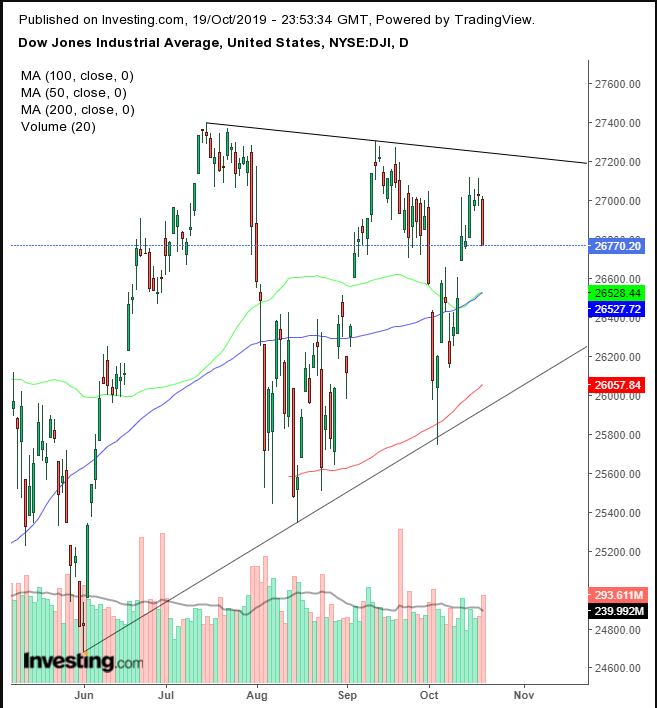Markets, particularly currency trade and especially sterling, will likely be volatile as the week begins. As well, expect gains across all markets to slip, as optimism over the prospect of a Brexit deal between the UK and EU—touted by UK Prime Minister Boris Johnson late last week as a virtual certainty—fades, after the British Parliament deferred Saturday's vote in order to have more time to study the details.
As a result, Johnson was forced by law to request an extension from the EU, after repeatedly vowing he would not do this. European Council President Donald Tusk will discuss the request with EU leaders, while Johnson plans to try and push the deal through at his end.
Last week, the U.S.'s third quarter earnings season kicked off, with major banks reporting mostly solid earnings versus depressed investor expectations, leading the group and most U.S. benchmarks, higher. Overall, U.S. equities eked out gains on a weekly basis but fell Friday with Boeing (NYSE:BA) plunging -6.79% on additional bad news for the U.S. aerospace giant. Microsoft's (NASDAQ:MSFT) losses on Friday allowed Apple (NASDAQ:AAPL) to take back the lead as the world's most highly valued company.
Technicals Signaling Tops; Economic Data Turns Negative...Again

The Dow Jones Industrial Average (-0.95%) underperformed on Friday after closing on Thursday just 1.25% below its July 15 record. Boeing (NYSE:BA), the most heavily weighted stock on the 30-component mega cap index, accounted for roughly two-thirds of its selloff. The avionics manufacturer which has been in the news for months now, made fresh headlines on Friday after regulators charged that the company neglected to disclose communications between its employees in 2016 during the certification of the now grounded 737 MAX jet.
Technically, Friday’s trading erased four days of advances, on the highest volume since Oct. 2, when the index dropped 1.8 percent, after nearing record highs. For the week, the Dow retreated 0.2%.
We pointed out in last week's post that fundamentals were improving while technicals were flashing warning signs. Though U.S. corporate earnings thus far have been relatively upbeat, after Morgan Stanley (NYSE:MS) on Thursday became the latest big bank to buck concerns about weak growth, technicals on U.S. indices increased chances of topping out.
Also, economic data flipped negative once again. U.S. retail sales disappointed, and the International Monetary Fund (IMF) lowered, yet again, its projections for global growth this year from 3.5% to 3%. Traders will also be mulling the data from China, released early Friday, which showed GDP had slowed to 6% in the third quarter, with limited pick-up from domestic demand, but factory output had improved and retail sales held up.

The NASDAQ Composite slumped -0.83% on Friday, with Microsoft (-1.63%) leading tech firms lower. Technically, the price neared the neckline of a potential H&S top, whose development was accompanied by falling volume. The tech heavy index gained 0.4% for the week.

Treasurys fluctuated but remained unchanged. The U.S. 10-year note closed at the top of a symmetrical triangle, situated below the downtrend line since November 2018.

The Dollar Index fell for a fourth straight day, after slipping below the bottom of its rising channel since June, closing below the 200 DMA for the first time since July.

The pound is expected to plunge when FX trade opens this coming week, unless some drastic new twist toward a Brexit deal materializes. Technically, the pound surged through both the downtrend line since May and its uptrend line since August. Unless a miraculous deal emerges, the pound is likely to retest the broken downtrend line toward 1.2600.

Oil closed slightly lower after fluctuating throughout Friday's session, finishing at the bottom of a rising flag, bearish after the preceding sharp downturn. If completed, it will imply a downside breakout of a larger descending triangle singe April 2018 and the top of a rising channel since August, on high volume, after cutting through the 200 DMA.
The Week Ahead
All times listed are EDT
Sunday
21:30: China – PBoC Interest Rate Decision
Monday
20:30: Australia – RBA Meeting Minutes: expected to provide additional insights into current—and possibly future—Aussie interest rate policy.
Tuesday
8:30: Canada – Core Retail Sales: anticipated to edge up to 0.1% from -0.1%.
10:00: U.S. – Existing Home Sales: likely to decline slightly, to 5.45M from 5.49M.
Wednesday
10:30: U.S. – Crude Oil Inventories: forecast to plunge to 2.878M from 9.281M.
Thursday
4:30: Germany – Manufacturing PMI: seen to have edged up to 42.0 from 41.7.
7:45: Eurozone – ECB Interest Rate Decision: expected to remain at 0.00%.
8:30: U.S. – Core Durable Goods Orders: probably plunged to -0.1% from 0.5%.
10:00: U.S. – New Home Sales: seen to have edged down to 700K from 713K.
Friday
4:00: Germany – Ifo Business Climate Index: expected to edge down to 94.4 from 94.6 previously.
6:30: Russia – Interest Rate Decision: forecast to remain at 7.00%.
